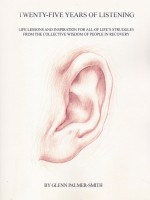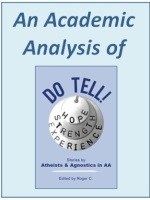Chapter 7:
Do Tell! Stories by Atheists and Agnostics in AA
Brent P.
In returning to AA in 2010, broke and briefly homeless, I had already decided, before someone made the point by asking, “so what are you going to do differently this time?”, that I indeed had to change my attitude to AA.
After 27 years of toying with the program I knew that one more flagrant, arrogant FU from me to AA spelled the end. It’s only in AA that so many stories begin with “The End” and, if fortunate, end with “The Beginning”.
The End
An alcoholic addicted to opiates and crack cocaine, I had fulfilled two of the three prognostications promised to alcoholics if they continued to drink: institutions, jail and/or death. You can figure out the one I’ve eluded so far.
Nevertheless I knew what it meant to be a “shivering denizen” of King Alcohol’s dark realm. I had experienced those last 10 to 15 years of absolute horror. The ominous, apocalyptic sound of the Four Horsemen’s mounts, their hooves pounding relentlessly with grim determination, shot electric fear through every nerve in my body.
What I had come to believe was my last stab at AA began when I came out of an institution that treats alcoholics. A hospital that medically detoxed me then put me into a program that fundamentally told me a lot of what I already knew. My brain was damaged as was my liver. The degree to which either would repair themselves was entirely up to me and my constitution. But the real message was, stop assuming that you’re at the head of the class, shut up and take seriously what others can tell you about alcoholism and addiction, whether doctors or peers in AA.
After seven weeks of balanced meals, exercise, massage, acupuncture, art therapy, doctor’s lectures, group therapy and other things I can’t remember, I was polished, dressed up and pushed out the door. They’d done all they could, including suggesting I start attending AA meetings (again!). ASAP.
There were a few days of sleeping on a friend’s couch before I secured a small bachelor’s apartment.
Now, I wonder, have I painted my self portrait clearly enough that you can picture me in your mind? Low bottom drunk/drug addict with a high opinion of himself. Dirty, rough looking, someone you’d hurry past on the sidewalk?
If that’s what you imagine, you wouldn’t be too far off the mark.
However it only took three of those 27 years to arrive at that station. The previous twenty four years I was a successful advertising copywriter. I traveled to some of the world’s most exotic locations, with a hefty expense account, to make commercials. Commercials!

A doctoral dissertation – “Experiences of Atheists and Agnostics in AA” – is based on the book Do Tell. For more information click on the above image.
Though not rich I was at the upper end of the wage scale. I had a salary that allowed me to buy and sell – one at a time – a 3 story building that was renovated to the nth degree, two houses in a very desirable downtown neighborhoods and, finally, a condo that was one of 17 unique units in what had once been a carpet factory.
I moved there shortly after an embarrassing incident cost me my partnership in a start-up agency. Or almost did. Since our partnership agreement was still to be completed, the other two partners had no basis upon which to sever me from the partnership. Nevertheless they wanted me gone. Some sort of arrangement would have to be crafted. Basically it would involve them paying me to stop showing up there.
I was in a rehab when the negotiating began. I left it to my brother to act for me. He happened to be the CEO and one of three senior partners in a sizeable law firm. That he was also a chartered accountant meant I had formidable representation. My brother and the accountant who was representing my partners, settled on a low six figure payout.
I won again, or so it appeared. Back in charge of my own life I decided I could take six months off; rest, recuperate, then like Lazarus, rise to take the job market by storm. I had to pause to admire my fine work! I was already calculating what a spectacular financial year it was going to be. Double the amount I’d settled for and that’s what my salary would be. Easy Street would be my address once again.
There was a recession and advertising agencies couldn’t afford much more than one senior guy like me and he/she was usually the creative director. While I thought I was perfectly cut out to be a creative director, nobody else appeared to share that confidence. My reputation had changed from one of a young, clever, big picture copywriter, to serious drunk, who looked and smelled the part. If you got me on a run of good days, then you were lucky; a run of bad days and anything could happen. I once passed out in an important meeting, my face dropping, slowly at first then more rapidly, until it was flat on the boardroom table. That ground the meeting to a halt while I was removed.
When I won that payout from my former partners, I didn’t realize that was it for me in the advertising business.
Fast forward a few years, after I’d been robbed by masked, armed crack-heads, been ripped off for $13,000 in a set up dope deal and repeatedly seen the most nightmarish side of humanity, I knew it was time to get out of Dodge. So I sold my condo and moved to an apartment in one of the city’s nicer neighborhoods. With the cash from the condo I could buy drugs and booze by the bundle and not have to leave the apartment for days.
I lived that way for about a year and I knew my brain was not functioning properly, that the tiny strokes that occur in your brain every time you smoke crack, were catching up to me. That every time I smoked crack I could have a sudden, crippling stroke. The alcohol I needed to accompany every crack-isode was so that I didn’t go into a major panic attack and bite my tongue off, was burning through the lining of my stomach. I was mixing vodka with Pepto Bismol and still my stomach burned and stung like I’d swallowed a swarm of bees. Finally, what started out as an occasional thing to help me sleep, opiates were required every day in greater and greater amounts. So when my brother finally caught up with me and said, “you need help”, I wrapped my arms around his waist – I was sitting and he was standing – buried my head just below his chest and let go with great heaving sobs.
So what are you going to do differently this time?
I was just over seven or eight weeks sober and still in a complete fog. Work wasn’t an issue since I didn’t have any nor could I have done any. I went primarily to daytime meetings and usually just sat there. On one of those occasions I thought to myself, “This is what you do all the time. Once you start feeling better you become argumentative, challenging the crap that inevitably drives you nuts. Then when you feel like you’re back to normal, you tell yourself you can’t take anymore of the nonsense and you stop coming”.
That was something I could do differently. The next change was a deal I made with myself; I could say anything I wanted in AA as long as it wasn’t driven by anger, wasn’t meant to be provocative nor could it be hurtful. Sure, it sounded good but could I do it? Turned out, with a little practice, I could. In fact with the nonsense I found amusing ways to show it for what it was.
It took awhile but I joined that group and pitched in all I could. It wasn’t until six months that you could chair a meeting so that kept being held out to me as a carrot. What they didn’t know was that I had severe anxiety accompanied by panic; the very last thing I wanted to do was chair a meeting. Rather than let that drive me out, as it had in the past (without knowing it part of my drinking and using was me self medicating), I decided I needed some outside help.
I finally ended up with two doctors, remarkable men whose compassion was equaled only by their BS detectors. I was prescribed a mild tranquilizer to use only in the most extreme cases (I only ever had a few pills at any time) and I was taught how to relax. Relaxing is a skill that you have to practice before you can really use it. But I practiced and if I still couldn’t halt the anxiety in a critical (to me) circumstance, I had the medication as back up.
I had dealt with two of the things that could make me walk out of a meeting, but there was another that had been a deal breaker so many times in the past – God and all the Judeo Christian constructs that infused many of the meetings. Add to that a Big Book that hadn’t changed in 75 years – I think it still refers to wives as “the little woman” – a book that people read and re-read as if there were treasure buried deep in its pages.
It was then somebody suggested I checkout AA Agnostica. I was suspicious. But I returned several times and finally wrote a kind of harsh rebuttal to one of the articles that appear fresh and new every week. They thanked me for my opinion!
I was invited to contribute some articles to the site. And as happy as I felt I could be in my regular AA group, I was growing more and more connected to this movement that became noticed here by virtue of an Intergroup hearing and ruling that would determine if secular groups in Toronto could be listed. They couldn’t. But that didn’t seem to impede the progress of AA Agnostica. The website flourishes as many are drawn to it and, for the first time, an atmosphere of open mindedness – not the kind that means turning off your critical faculties so you can accept a fairy tale as the reason for your sobriety – but instead the kind that encourages new ideas while caring little or nothing for your religion. AA Agnostica, the website, is a barometer of the movement around the world while bringing hope to people who either had to keep their thoughts to themselves or often live with them bottled up. The optimism the site exudes is palpable and compelling, telling this alcoholic, AA is changing and one day, in the not to distant future, the secular meetings and their members will be leading the charge to an AA that enjoys a symbiotic relationship with Science & Medicine, Mental & Physical Health Facilities and much more.
So I thank AAAA and AA Agnostica for giving me the hope I’m not certain I ever had. And I thank AA for its groundbreaking work and the vital insight it brought to treating that most acute symptom every alcoholic struggles with, loneliness. AA is a real community that AAAA continues to learn from and show gratitude towards.
Despite the fact that I’m still broke and on a disability pension that barely covers my monthly costs, I’m happy. I have inside help and I have outside help. My current doctor is a member of AA herself and actively involved in the science of addiction.
And for the first time in my life I wake up almost every morning now and on the cinema screen in my head I see, in a fantastic font, the words I’ve so desperately wanted to see at the introduction to my story:
The Beginning
![Do Tell! [Front Cover]](https://nrdblogs.nationalrehabdirectory.net/wp-content/uploads/2020/09/Do-Tell-Full-Blue-Front-Cover-200-FRAMED.jpg) This is a chapter from the book: Do Tell! Stories by Atheists and Agnostics in AA.
This is a chapter from the book: Do Tell! Stories by Atheists and Agnostics in AA.
The paperback version of Do Tell! is available at Amazon. It is also available via Amazon in Canada and the United Kingdom.
It can be purchased online in all eBook formats, including Kindle, Kobo and Nook and as an iBook for Macs and iPads.
The post The Beginning first appeared on AA Agnostica.

 In addition to being an accomplished chronicler of what he has heard at meetings, Glenn is also a gifted artist; scattered copiously throughout the written pages are pencil sketches he’s drawn of alcoholics at the New York City meetings he attends, being careful, he notes, to protect their anonymity.
In addition to being an accomplished chronicler of what he has heard at meetings, Glenn is also a gifted artist; scattered copiously throughout the written pages are pencil sketches he’s drawn of alcoholics at the New York City meetings he attends, being careful, he notes, to protect their anonymity.


![Do Tell! [Front Cover]](https://nrdblogs.nationalrehabdirectory.net/wp-content/uploads/2020/09/Do-Tell-Full-Blue-Front-Cover-200-FRAMED.jpg) This is a chapter from the book: Do Tell! Stories by Atheists and Agnostics in AA.
This is a chapter from the book: Do Tell! Stories by Atheists and Agnostics in AA.